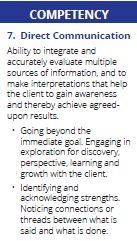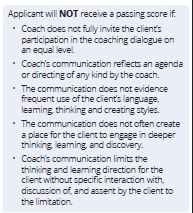Direct communication requires accurately evaluating and interpreting multiple sources of  information. For example, an awareness of the client’s intended meaning, learning style, and personality is foundational to really hearing them and then in turn responding to them effectively. Direct communication must be respectful both of the client and of the coach; how something is said makes a difference. Language tools are essential for this competency. These include the ability to adjust to the client’s language, their personality, and their learning style. It means knowing specific words that are ineffective and words that work well. Application of the direct communication competency also involves inviting direct communication from the client.
information. For example, an awareness of the client’s intended meaning, learning style, and personality is foundational to really hearing them and then in turn responding to them effectively. Direct communication must be respectful both of the client and of the coach; how something is said makes a difference. Language tools are essential for this competency. These include the ability to adjust to the client’s language, their personality, and their learning style. It means knowing specific words that are ineffective and words that work well. Application of the direct communication competency also involves inviting direct communication from the client.
 If a coach communicates in a round-about way, then they will fail this competency at any level. If the coach softens what they are saying, says too much, or explains their questions then they have limited skill with this competency. If the coach limits the client’s participation, fails to flex to their language and style, or follows their own thinking then they will fail the higher levels of the competency evaluation.
If a coach communicates in a round-about way, then they will fail this competency at any level. If the coach softens what they are saying, says too much, or explains their questions then they have limited skill with this competency. If the coach limits the client’s participation, fails to flex to their language and style, or follows their own thinking then they will fail the higher levels of the competency evaluation.
Direct communication in coaching honors and respects both the coach and the client. It means the coach is asking instead of telling, focused on the future, and succinctly saying what they really mean. It invites open dialogue and enhances the value of the coaching conversation.



